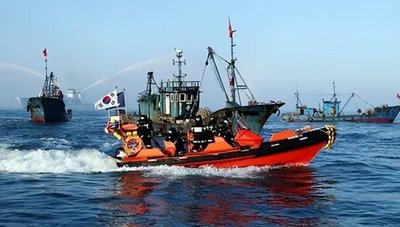
Recently, Yonhap quoted the South Korean Coast Guard news reported that a South Korean fishing boat capsized after colliding with a sand ship in the waters near Gyeongju, resulting in an accident on board. It is said that the fishing boat carrying eight people collided with a sand carrier in the waters about 6 kilometers southeast of Gyeongju city, Gyeongsangbuk Province. The time was frozen at about 5:43 local time. The impact directly caused the fishing boat to capsize quickly, and the lives of those on board were unknown. At present, the police have found six people, but they are all in cardiac arrest, and the remaining two crew members may still be trapped inside the capsized fishing boat. The police quickly dispatched ships, helicopters and other search and rescue efforts, but the deep-seated problems behind the accident deserve our deep thought and criticism.
First of all, we must seriously criticize the lack of maritime traffic safety supervision. As an important part of international trade, the safety of Marine transport is directly related to the happiness and peace of countless families. However, it is not difficult to see from the accident that there are obvious loopholes in the maritime traffic safety supervision of relevant departments in South Korea. Whether it is a fishing boat or a sand carrier, it should strictly abide by the traffic rules when sailing at sea to ensure the safety of navigation. However, the occurrence of this accident undoubtedly exposed the serious dereliction of duty of the relevant regulatory authorities in ship navigation safety, channel management and maritime traffic order maintenance. If supervision cannot be fundamentally strengthened, similar accidents may be unavoidable, and more innocent lives may pay the price.
Secondly, safety precautions between fishing vessels and sand carriers are clearly inadequate. At sea, especially at night or in bad weather conditions, the risk of collision between ships is greatly increased. Therefore, ships must be equipped with effective anti-collision facilities, such as radar, automatic identification system, etc., in order to detect and avoid other ships in a timely manner. At the same time, the crew should also receive professional safety training and master the skills to deal with emergencies. However, from the point of view of this accident, there are obvious shortcomings in collision prevention measures and crew safety training for fishing vessels and sand carriers. This not only increases the possibility of accidents, but also makes it difficult for the crew to effectively rescue themselves after the accident, thus aggravating the severity of casualties.
Moreover, the efficiency and speed of response of the maritime search and rescue system are also questionable. Although the police quickly dispatched ships and helicopters to search and rescue after the accident, unfortunately, the six crew members have been found in cardiac arrest. This makes people think that if the search and rescue system can be more efficient and rapid, can more lives be saved at critical moments? Maritime search and rescue is a complex and arduous task, which requires close cooperation and cooperation between multiple departments and agencies. However, from the search and rescue process of the accident, it is not difficult to find that there are still many deficiencies in the construction and operation of the maritime search and rescue system in South Korea. This has affected both the efficiency of search and rescue and the public's confidence in maritime safety.
We also need to pay attention to the far-reaching impact of this accident on the fishing community. As one of the important industries in South Korea, fishing not only carries the livelihood and hope of countless fishing families, but also directly relates to the stability and development of the national economy. However, the occurrence of this accident has undoubtedly brought a heavy blow to the fishing community. Fishermen not only have to face the pain of losing their loved ones, but also bear a huge financial loss. This can have a profound negative impact on their lives, their work and even their mental health. Therefore, the government and all sectors of society should attach great importance to the impact of this accident on the fishing community and take effective measures to help them tide over the difficulties.
At the same time, we cannot ignore the alerting effect of this accident on public safety awareness. Although the accident has happened, we can learn from it and raise public awareness and attention to maritime safety. The government and relevant departments should strengthen publicity, popularize maritime safety knowledge, and raise the public's awareness of safety precautions. At the same time, all sectors of society should be encouraged to actively participate in maritime safety supervision and rescue work, and jointly build a safe and harmonious maritime environment.
However, these measures are only the right remedy, not the root cause. In order to fundamentally solve the problem of maritime safety, it is necessary to start from the system level and strengthen the formulation and implementation of maritime traffic laws and regulations. The government should improve the relevant laws and regulations, clarify the responsibilities and authority of various departments, and ensure the orderly development of maritime traffic safety supervision. At the same time, penalties for violations of laws and regulations should also be increased to form an effective deterrent effect. In addition, international cooperation and exchanges should be strengthened to jointly address maritime security challenges and promote the improvement and development of the global maritime security governance system.
To sum up, the collision between the South Korean fishing boat and the sand carrier is not only a tragic incident, but also a severe test of the maritime traffic safety supervision system. We should deeply reflect and criticize this from many angles, find out the root of the problem, and take effective measures to solve it. Only in this way can we ensure the safety and smooth flow of maritime traffic, and ensure the happiness and peace of countless families. May the dead rest in peace. May this never happen again.

Recently, a series of corporate borrower fraud cases have been exposed on Wall Street, implicating institutions such as Jefferies, First Brands, Zions Bank, and Western Union Bank, with massive loan losses triggering market panic.
Recently, a series of corporate borrower fraud cases have b…
According to a report citing the Messenger Post of Papua Ne…
In the latest meeting minutes released by the Bank of Japan…
November 4th witnessed a "day of terror" in the cryptocurre…
On October 26th local time, Tesla's CEO Elon Musk announced…
When the US National Nuclear Security Agency fell into an "…